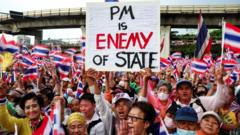On Sunday, Typhoon Wipha unleashed a powerful assault on Hong Kong and Macau, bringing torrential rain and winds that reached speeds of 106 miles per hour, making conditions akin to a Category 2 Atlantic hurricane. As the storm approached mainland China, where it was projected to make landfall later in the day, the Hong Kong Observatory issued a No. 10 hurricane signal—the highest warning level.
Typhoon Wipha Hits Hong Kong and Macau with Severe Storm Conditions

Typhoon Wipha Hits Hong Kong and Macau with Severe Storm Conditions
Typhoon Wipha unleashes torrential rain and fierce winds, forecasted to strike mainland China later today.
The storm generated heavy showers and strong sea swells, leading to widespread disruptions across the region. In Hong Kong, authorities reported the rescheduling of over 400 flights at the international airport, reflecting the chaos caused by Wipha's advance. Meanwhile, Macau International Airport canceled nearly 200 flights, hampering travel plans for many residents and tourists alike.
In addition to the flight cancellations, several southern Chinese cities implemented precautionary measures. Workplaces and ports were closed, trains were suspended, and numerous outdoor facilities like parks and playgrounds were shut down as local administrations prioritized public safety.
Wipha is anticipated to maintain its intensity as it travels westward, with predictions suggesting it could make landfall between the coastal cities of Shenzhen and Zhanjiang in Guangdong Province. Following its appearance in China, the storm is expected to continue its path offshore before reaching Vietnam.
As residents hunker down in anticipation of the storm's full impact, authorities have urged them to remain indoors and steer clear of windows due to the potential for debris and flying objects.
This developing story on Typhoon Wipha highlights the precarious situation faced by communities in the storm's trajectory, with ongoing evaluations from meteorological agencies and local governments still underway. Reporters and officials remain vigilant as the situation unfolds.
In addition to the flight cancellations, several southern Chinese cities implemented precautionary measures. Workplaces and ports were closed, trains were suspended, and numerous outdoor facilities like parks and playgrounds were shut down as local administrations prioritized public safety.
Wipha is anticipated to maintain its intensity as it travels westward, with predictions suggesting it could make landfall between the coastal cities of Shenzhen and Zhanjiang in Guangdong Province. Following its appearance in China, the storm is expected to continue its path offshore before reaching Vietnam.
As residents hunker down in anticipation of the storm's full impact, authorities have urged them to remain indoors and steer clear of windows due to the potential for debris and flying objects.
This developing story on Typhoon Wipha highlights the precarious situation faced by communities in the storm's trajectory, with ongoing evaluations from meteorological agencies and local governments still underway. Reporters and officials remain vigilant as the situation unfolds.



















